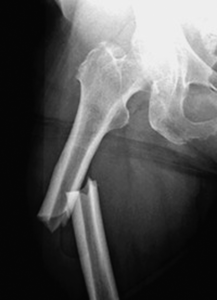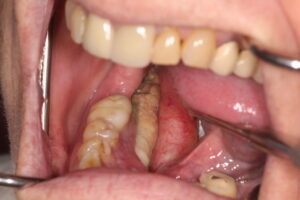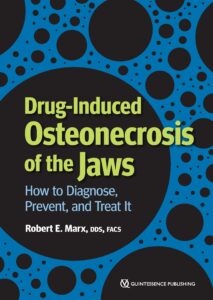 Take a look at this radiograph. What do you think happened to this person’s leg to make it snap in half? A car accident? A fight? A bad fall? No, no, and no. This femur fracture is the result of extended use of alendronate (Fosamax) in a patient with osteoporosis.
Take a look at this radiograph. What do you think happened to this person’s leg to make it snap in half? A car accident? A fight? A bad fall? No, no, and no. This femur fracture is the result of extended use of alendronate (Fosamax) in a patient with osteoporosis.
So how did a drug that’s supposed to treat porous bone lead to bone fracture? To answer this question, first we have to understand how osteoporosis drugs work. Osteoporosis is a disease whereby bone loses some of its cortical thickness and the medullary trabecular struts between the cortices become thin and disconnected, leading to porous bone susceptible to fracture. Our entire skeleton is constantly in a state of renewal and remodeling, as old bone is resorbed and new bone is deposited to maintain a healthy skeleton. Drugs prescribed to treat osteoporosis are effectively cellular poisons that slow down the bone-resorbing portion of the remodeling cycle to allow bone formation to catch up with bone resorption, bolstering the weak bone.
Now let’s get back to the femur. The femur is the longest bone in the human skeleton, and as such, it flexes at its midshaft every time the knee bends (eg, when we walk or run). This creates an increased demand for bone remodeling and renewal in this midshaft area. By introducing drugs that slow down the renewal process, old bone becomes brittle and can simply snap, hence the clean fracture line observed in the radiograph.
 But the femur isn’t the only area affected by osteoporosis drugs. The other vulnerable area in the body is the alveolar bone in the mouth, which turns over at a rate 10 times faster than that of long bones. This is why drug-induced osteonecrosis of the jaws (DIONJ) always begins in the alveolar bone.
But the femur isn’t the only area affected by osteoporosis drugs. The other vulnerable area in the body is the alveolar bone in the mouth, which turns over at a rate 10 times faster than that of long bones. This is why drug-induced osteonecrosis of the jaws (DIONJ) always begins in the alveolar bone.
DIONJ is defined as exposed nonhealing bone in the mandible or maxilla that is present for more than 8 weeks in a person who received a systemic drug known to cause ONJ but who has not received a local tumoricidal dose of radiation to the jaws. (Because radiation will also kill bone.) For 20 years Dr Robert Marx has been talking about DIONJ (formerly bisphosphonate-induced ONJ) and the dangers of bisphosphonates and other osteoporosis and cancer drugs that cause ONJ. In his latest book on the topic, Drug-Induced Osteonecrosis of the Jaws: How to Diagnose, Prevent, and Treat It, available in November 2021, Dr Marx not only explains the mechanism behind DIONJ but more importantly outlines (1) how to treat it once it occurs and (2) how to prevent it when DIONJ-causing drugs are still necessary.
 After all, when these drugs are being used to treat life-threatening cancer, avoiding them is not a great option. By understanding the science behind DIONJ, you can make clinical decisions to maximize the effectiveness of these drugs while minimizing their harmful effects. DIONJ doesn’t have to be inevitable in patients with osteoporosis or cancer. Make sure you’re educating yourself on how to protect your patients’ alveolar bone and quality of life. Preorder your copy today!
After all, when these drugs are being used to treat life-threatening cancer, avoiding them is not a great option. By understanding the science behind DIONJ, you can make clinical decisions to maximize the effectiveness of these drugs while minimizing their harmful effects. DIONJ doesn’t have to be inevitable in patients with osteoporosis or cancer. Make sure you’re educating yourself on how to protect your patients’ alveolar bone and quality of life. Preorder your copy today!
About the book
Drug-induced osteonecrosis of the jaws (DIONJ) is something oral surgeons are all too familiar with. For decades Dr Marx has been advocating for drug holidays and other clinical tactics that can help mitigate the effects of bisphosphonates and other DIONJ-causing agents, particularly in patients being treated for osteoporosis or cancer. Now his goal is to equip doctors and surgeons to treat it effectively and prevent it whenever possible, and this book compiles all of his strategies and guidelines to do just that. The first chapter explains the mechanism of action of DIONJ as well as its risk factors and staging, and the following chapters outline how to diagnose, treat, and even prevent DIONJ in patients with osteoporosis and cancer. Twenty cases are included to show how DIONJ presents clinically and what to do in each situation based on severity and patient condition. After all, runaway cancer is life-threatening, so simply avoiding DIONJ-causing drugs is not always feasible. That is why Dr Marx gives clear and practical information on how best to handle each situation, so oral surgeons and other clinicians can craft the best possible treatment plans for their patients.
104 pp; 105 illus; ©2022; ISBN 978-1-64724-089-9 (B0899); US $46 (preorder)
